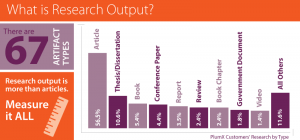Telling their Research Story: Helping Faculty Navigate Research Metrics with PlumX
This guest blog is written by Andy Herzog, Department Head of Faculty Services and Online Engagement for the University of Texas Arlington Libraries. He is heading up a program to help support faculty members through the process of promotion and tenure.

The University of Texas at Arlington (UTA) Libraries are piloting a new service to support our faculty’s promotion and tenure process. In the past, upon request, librarians have helped faculty pull information about their research metrics (article citation counts, h-index, etc.). Only a few faculty took advantage of this service, likely because they did not realize that librarians could assist them in this capacity. Based on a perceived faculty need, our pilot focuses on targeted marketing of an expanded metrics evaluation consultation that results in a customized report that faculty can incorporate into their promotion and tenure dossier.
We approach these consultations by thinking holistically about the impact of a faculty member’s scholarship. The Becker Model, originally developed to determine the impact of health sciences scholarship, provides a good framework for this process although it must be adapted to different disciplines. The model groups impact into the following categories: advancement of knowledge, clinical implementation, legislation and policy, economic benefit, and community benefit. When we have spoken to faculty about their promotion and tenure process, they have expressed difficulty quantifying the impact of their work that is not traditionally measured via citation counts. Faculty would like to tell the full story of the impact of their research and be credited for interest generated by their work.
So what’s that look like?
The consultations utilize the same skillset we use to conduct a reference interview and are conducted by members of the Faculty Services & Online Engagement department, which includes Lydia Pyburn, Mitch Stepanovich, Ruthie Brock, and Carol Byrne. We start by establishing what the faculty member’s college requires for promotion and tenure, what their field values, and what questions they have about the impact of their work. Sometimes faculty have a very good idea of what they would like and sometimes they don’t. In addition, we have a series of follow up questions like:
- Who uses your work?
- How do you share your work?
- How do scholars interact with each other in your field?
- Is your work used by practitioners or the public?
We talk about available data sources, their limitations, and the positive and negative attributes of different metrics. We use this consultation to gather information to prepare a customized report for the faculty member. Although we are not doing as deep of an analysis as the Becker model, we can use altmetrics, provided by the Plum Analytics company’s product, PlumX, to give more data about different types of impact. PlumX provides altmetric data, covering interest beyond citations: usage, captures, mentions and social media. For some faculty, citations can be a long time coming. But today, as we look at the many ways that information is shared and referenced outside of citations, we are capturing a much more up-to-date picture of the reach of research. This is not a question that faculty directly ask, but sometimes I make sure to say that we are not judging their work. We are helping them understand the different metrics available and how we are gathering data.

Segue to digital identity
This discussion offers a natural segue to what faculty can do to increase dissemination, better track their data, and enhance their digital identity. Before the consultation, we examine their digital footprint. Do they have an ORCID ID, a personal website, an academic social network profile, or a YouTube account? Do they blog about their field and their work? Do they deposit in our institutional repository or use Twitter as an academic? Based on what they already do, as part of the report, we can offer advice on various tools that will assist them with growing their digital footprint.
Creating the report
After conducting this consultation, our report is shared with the faculty member within two weeks. We are in the process of developing a workflow for incorporating visualizations into the report. We have taken inspiration from other libraries in designing this report. In particular, we took elements from Emory Libraries and the University of Manchester. Unlike for these institutions, altmetric data is often an important aspect of our report. Additionally, as far as I can tell from their websites, they do not pair their consultation service with advocacy towards enhancing their faculty’s digital identity. We feel this is an important value-added service from UTA Libraries.
Getting started with PlumX
PlumX is a central tool in this process. This software system provides the majority of our altmetrics. It follows 67 types of data they call ‘artifacts.’ These metrics fall into the categories of usage, captures, social media, mentions, and of course, citations. We subscribe to PlumX with the long-term goal of incorporating it into our faculty profile system. Instead of waiting for the full implementation of this system, we have moved ahead with this new software service, using it internally to provide data. Additionally, we use traditional tools from Google and Web of Science.

Why this service is a priority at UT Arlington Libraries
As with all new services, they should be connected to your university’s strategic plan and meet the needs of your users. UT Arlington is a growing research institute—shedding our image as a commuter college. Even though we recently were named an elite research 1 institute by the Carnegie Classification, we are still in the process of changing perceptions. Our university strategic plan reflects this by emphasizing faculty excellence. In response, our library has structured part of the strategic plan around increasing faculty resonance, to accelerate the recognition and use of scholarship and creative works. They do the work. They should be rewarded with the credit for it that they deserve.
“My speculation is that by starting with the problems faculty face, and establishing altmetrics as one the many data points that define a faculty member’s research story, there will be ever increasing use for this service. In our conversations, one assistant dean said ‘altmetrics might have value for those faculty on the margins. And everybody thinks they are on the margins.'” — Andy Herzog
Response so far
At this stage, we have only completed a few sessions and reports. More are scheduled in November. Anecdotally, faculty seem pleased with the service. We will be conducting a more formal assessment in the future. Humanities faculty in particular have been very interested in altmetrics because there are fewer established tools that accurately track traditional impact metrics.

Science faculty have been interested in usage data and also in the comparative citation data of Essential Science Indicators. As part of launching this service, we spoke to deans, assistant deans, and assistant provosts. Our university administration values data, and they have been supportive of this service, eager to see how we can support faculty in their work. As a developing field, there are a lot of questions around the value of altmetrics. My speculation is that by starting with the problems faculty face, and establishing altmetrics as one the many data points that define a faculty member’s research story, there will be ever increasing use for this service. In our conversations, one assistant dean said “altmetrics might have value for those faculty on the margins. And everybody thinks they are on the margins.”